Mum Cuttings are Arriving!
I’ve been slowly sneaking garden mum tips into this newsletter for a few weeks, just to get you thinking about the next major crop hitting your plate while your spring crops are (hopefully) shipping out fast and furious. Now, it’s time to go into mums full-force, because the shipping reports tell me that boxes of mum URCs are hitting the road, destined for greenhouses across North America.

Getting those young plants started strong is key to the whole process of finishing top-quality mums with few losses. I want to share a few excellent resources to kick off Tech On Demand mum coverage that will no doubt extend over many weeks. Below, you’ll also find a catalog of tech tips from Nick, but I’ll let him cover those. The goal here is to arm you with as much info as possible to share with your team, bookmark and post so any issues that might arise can be quickly identified and managed.
Let's begin with a high-level look at culture offered by some of the large mum breeders and suppliers:
Ball Mums Resource Webpage: This is a virtual one-stop-shop full of technical info for mum growers—podcasts, videos, catalogs, tech sheets and a growth-tracking tool. Look for all the info on managing the risk of Chrysanthemum White Rust, a quarantinable disease you want to avoid at all costs.
Syngenta Mums Grower Success Guide: I was impressed when this one hit my inbox earlier in the week. Avoiding premature budding is super important in April and May, and Syngenta’s mum tech guru Mark Smith covered the issue in detail with an email to growers. Linked to the email was a guide covering garden mum growing from selection to finish. Check it out!
Dümmen Orange Grower Guide: In a concise three pages (easily printable for your team), you’ll find a culture overview covering all bases, as well as a thorough look at tips and trick to nail flower initiation. There’s also a deep dive into growing a shaded mum crop, plus plenty of other critical info.

Nick’s Tip of the Week: Tons of Garden Mum Tech Sheets
Each week, I’ll work with my buddy Nick Flax, a technical services expert at Ball, to share a concern that’s come up during one of his numerous calls with growers across North America. This week, he’s looking ahead to your garden mum production and sharing his library of technical tips—from diseases to nutrition to PGRs and more.
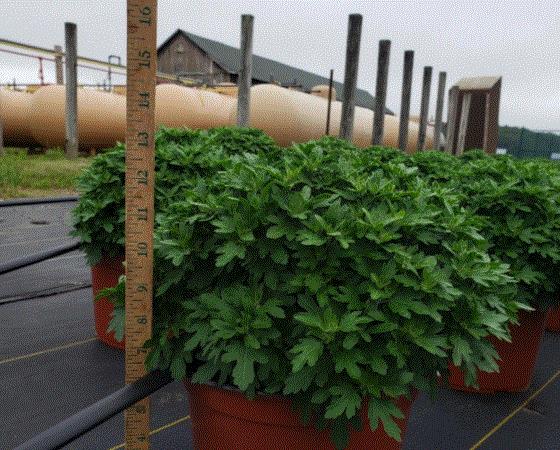
Bill called out the Ball Mums' webpage above and I want to make sure you clicked the link and scrolled down a bit to find a catalog of tips I’ve put together to help you head off common (and not-so-common) issues before they arise ... or effectively manage them if they do. Each document is linked below so you have them “one click away” for quick reference.
Bacterial leaf spot (BLS) is caused by Pseudomonas cichorii. While at first glance it is sometimes confused with fungal leaf spots, there are some key differences in symptoms and conditions for infection that make it a dead giveaway when it shows up in your crop.
Botrytis (gray mold) is a disease to watch for in mum production, and there are critical times when you should pay special attention to pressure. I also share other do’s and don’ts for managing this disease.
Crown budding is premature development of garden mum flower buds in response to cold night temperatures at any point in the supply chain. These buds flower much earlier than your target dates, leading to poor growth and decaying flowers. In this document, find strategies to alleviate crown budding.
Fusarium hits hardest when plants are under stress. Pressure from this pathogen typically doesn’t occur early in production, but more often mature crops (very close to ship dates) succumb to Fusarium. The good thing is, there are effective ways to prevent and manage the disease.
Pythium is one of the most frequently encountered root rot pathogens encountered in garden mum production. The most common symptoms include brown discoloration of roots and root cortex slippage, where the outer layer of the root slides off, leaving behind a thin, threadlike root portion. Find prevention and management tips in this document.
Nutrition provided to your crop and a solid fertilizer plan is often the difference between top-notch and poor-quality garden mums. In this tip, I start with “general” mum fertilizer best practices and then move on to some situational nuances.
Paclobutrazol drenches for your mum crop can be tricky, so I wanted to share some best practices. There are two functional ways to use paclo drenches in mum production:
-
Low application rates in the early or middle stages of production to tone and slow growth.
-
Higher application rates (relatively speaking) to cause a hard stop on mature crops that are budded but haven't stopping growing when you want them to.

Thrips parvispinus Follow-Up (An Overview)
Three weeks ago, I used a lot of words in this newsletter discussing the newish thrips pest that seems to be dominating horticultural news lately: Thrips parvispinus. This week, I’ve spent about five total hours attending webinars and having discussions with industry folks about the issue. There’s a lot going on related to this insect pest and, thankfully, leading experts are dedicating time and resources to create awareness and move us toward controls and solutions, because this is an issue that could affect us all.
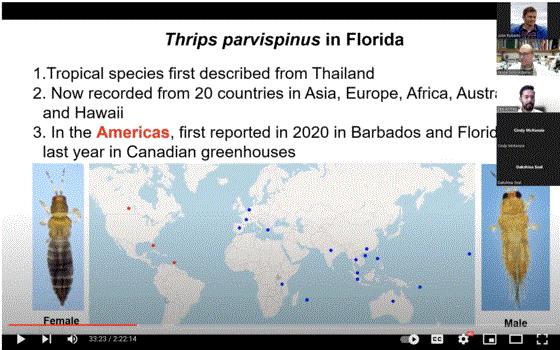
The first of two webinars I attended, hosted by the University of Florida/IFAS and featuring experts from Florida extension, USDA and the Florida Department of Ag, covered Thrips parvispinus in amazing detail—much of it was far beyond my layman’s understanding. But my takeaway is that, while the immediate impact to growers subject to quarantines due to this invasive pest is devastating, the sky is NOT falling. In fact, that term has been used a few times this week, because the early reports sounded pretty dire.
The FULL UF/IFAS WEBINAR is available online and I encourage you to watch, because it’s quite thorough. It was quite clear that although this pest has a wide host range, it very much prefers a few tropical crops: mandevilla, dipladenia, gardenia and peppers. These are the crops most at risk.
Yesterday, I attended a second webinar conducted by Horticultural Research Institute (HRI), in collaboration with AmericanHort, the Canadian Nursery & Landscape Association and American Floral Endowment. This one also featured a panel of experts and was concise and action-oriented. As of today, I don’t think it is yet available for viewing, but I’m hoping HRI will share it soon. When that happens, I’ll put a link in this newsletter.
In this one, Dr. Lance Osborne, the well-respected University of Florida entomology professor, covered the response of USDA-ARS, University of Florida and Florida’s Regulatory Agency (FDACS-DPI) to the detection of Thrips parvispinus and best practices related to observation and identification of the pest. Sarah Jandricic, greenhouse IPM specialist from the Ontario Ministry of Agriculture, Food and Rural Affairs, shared what damage looks like on different plants, where the thrips like to feed and hide on crops, and how she and her team have learned to monitor them in production. Lastly, IR-4 environmental horticulture program manager Cristi Palmer shared outcomes from international efficacy research and options available in the US for thrips management.

ACTION ITEMS: Thrips parvispinus ID & Control
I’m pretty sure you want to know what symptoms to watch for, and your control options. Basically, this thrips is tiny, fast, hides well, and requires more diligence than more common thrips species. They feed deep in the developing/unfolding leaf and flower tissue.
In addition to the common “trails and scars” left by other common thrips, Thrips parvispinus can also leave damage that resembles broad mite damage, as they also feed deep in tissues and can severely damage growing tips.
Monitoring crops that are at risk for Thrips parvispinus requires some work due to the characteristics above. Tap foliage onto a white surface and use a hand lens to compare thrips found to the images HERE. You will need a lens with at least 10x magnification—these insects are only about 1 mm long.
When feeding on host plants, Thrips parvispinus uses its mouthparts to scrape leaf surface, damaging foliage, and then sucks at the plant juices. Obviously, this causes severe damage to plants. From what I have learned, they prefer to feed on growing tips, and often the mature foliage below still looks okay. You can see this pretty clearly in the Hoya photo below (credit for this pic goes to Felipe Soto-Adames at FDACS-DPI). As soon as you see damage that you feel could be caused by Thrips parvispinus, you should send samples out for confirmation.
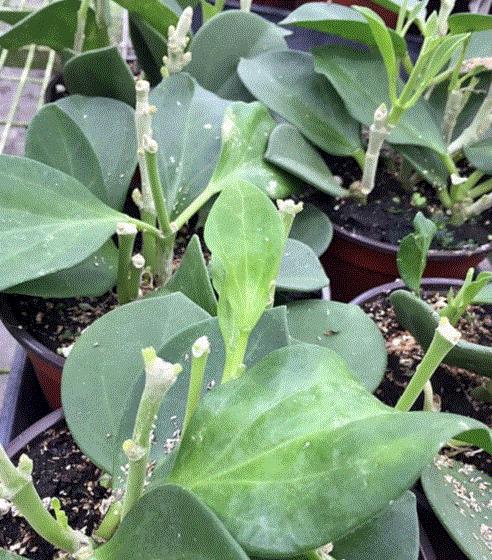
Research into effective controls has been conducted globally and here in North America, and control options definitely exist. We’re still learning quite a bit and there’s ongoing research into biological controls that look promising, including dips and beneficial predators like Steinernema feltiae, Orius insidious and Amblyseius swirskii or A. cucumeris. I expect that information to come soon, but for now, chemical controls have been shared.
Controlling Thrips parvispinus requires diligence, meaning a good rotation program (every five- to ten-day applications) and thorough application. Some suggested chemicals are Conserve (spinosad), a tank mix of Conserve + Avid (abamectin), XXpire (spinetoram + sulfoxaflor), Pylon (chlorfenapyr), Mainspring (cyantraniliprole; stops feeding immediately but takes multiple days to kill thrips) and Hachi-Hachi (tolfenpyrad). Others have reported success with Orthene (acephate), Kontos (spirotetramat), Sarisa (cyclaniliprole), Overture (pyridalyl) and Pedestal (novaluron).
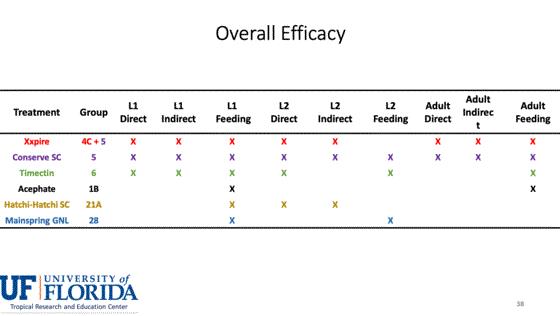
For far more detail about damage symptoms, complete with photos, as well as efficacy research and a much more comprehensive look at the effectiveness of potential controls, here’s a VERY DETAILED REPORT that I encourage you to review.

Let’s Talk Lupine
Last year around this time, our team worked with a grower who saw worrisome spots on a lupine crop. The spotting appears to be most prominent on older leaves, and when Tech On Demand experts talked with this grower, they mentioned high feed. This led to an assertion that the issue is nutrient-related.
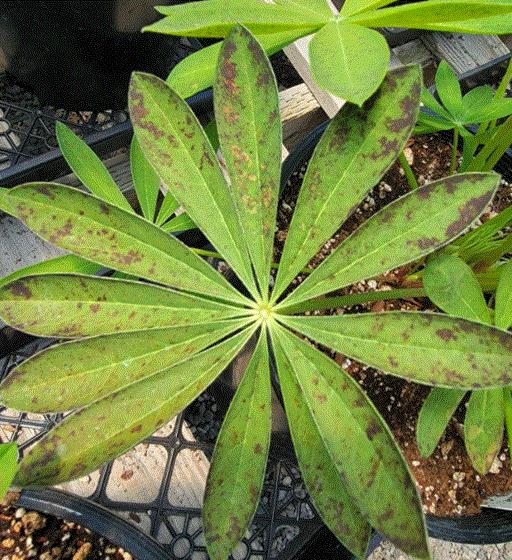
Dark spots and splotching on older leaves are common symptoms of iron/manganese (Fe/Mn) toxicity, so if the crop has been over-fed, this most likely the issue. Keeping a close eye on soil pH and EC is critical. When corrected, the crop should rebound.
This got me thinking about lupines, because they’re such a stunning impulse plant that shoppers have a hard time passing up at retail. I looked up tips for producing top-quality lupine and found a GROWERTALKS ARTICLE from a few years ago, written by a grower at Walters Gardens in Michigan. Here’s what they had to say regarding culture:
-
Moisture. Lupines prefer average soil moisture and require good drainage to thrive. Water them thoroughly and allow the soil to dry slightly between waterings. Plants that are held under wet conditions become prone to anthracnose. It’s best to water in the morning and allow the foliage to dry before evening.
-
Lighting. Lupines require long days to flower. To force them into bloom earlier in the year, day-extension or night-interruption lighting can be effective.
-
Temperature. If starting your lupines in the fall, grow them under natural temperatures, but maintain air temperatures above 50F (10C) until plants are rooted in. Once they’re well-rooted, they can be shut down for winter and vernalized for 6 to 8 weeks or longer below 40F (4C) in minimally heated greenhouses or unheated cold frames. If growing lupines in spring, grow them cool at 60 to 65F (15 to 18C) constant air temperatures.
-
Growing Media and Fertility. Lupines prefer to be grown in a well-drained, bark-based growing mix, which allows for better drainage. They don’t like heavy soils. A slightly acidic pH of 5.8 to 6.2 is best in production. Lupines are light to moderate feeders. Fertilize with a constant liquid feed of 75 to 100 ppm nitrogen at every irrigation or 150 to 200 ppm nitrogen as needed. If using a controlled-release fertilizer mixed into the growing media, use at a medium rate of 1 lb./cubic yard. The recommended EC rate using the pour-through method is 2.0 to 2.5.
-
Pests and Diseases. Lupines can be affected by several insect and disease issues, so it would be wise to maintain a preventative spray rotation on a biweekly basis. Scout for aphids, whiteflies and thrips, treating as necessary. Also watch for downy mildew, powdery mildew, anthracnose and rust. Drenching plants with a broad-spectrum fungicide at transplant can help to prevent disease. Crown and root rots can be prevented by not growing plants wet, especially at night.

Finish Line ...
What’s more fun that pests and diseases? Payroll! I jest, of course, but the topic is definitely one that all owners and managers need to understand, especially when it comes to the latest tax laws and regulations.
We ran an article titled PAYROLL 2023 STYLE in the March issue of GrowerTalks, and I took the liberty of releasing it as an audio podcast this week.
Thanks to Mark Battersby, the business finance expert who shared this information, specifics related to changes for 2023 and ways to control costs (tailored to greenhouse professionals) are detailed in an understandable way. Pop in your AirPods and TAKE 10 MINUTES TO LISTEN to what he has to say, because it will save you money and keep you on the right side of the law. And remember to subscribe to the Tech On Demand Podcast on your favorite app so you never miss an episode!
That’s a wrap for this week. The weekend weather forecast for Cleveland looks pretty decent, which is good because we need to go to the nursery and pick out new shrubs and perennials to fill a big space in front of our house that used to be overgrown with ugly bushes. They’re gone now, so let the new plant fun begin!
Talk to you next Friday!




Please feel free to send your comments, constructive criticism and topic ideas to me at bcalkins@ballhort.com.

Bill Calkins
Editor - Tech On Demand
This email was received by you and 26,287 other fine subscribers!
If you're interested in advertising in Tech On Demand, contact Kim Brown ASAP and she'll hook you up.